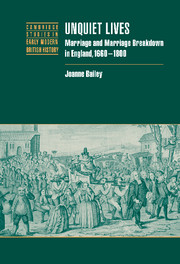Book contents
- Frontmatter
- Contents
- Acknowledgements
- List of abbreviations and conventions
- 1 Introduction: reassessing marriage
- 2 ‘To have and to hold’: analysing married life
- 3 ‘For better, for worse’: resolving marital difficulties
- 4 ‘An honourable estate’: marital roles in the household
- 5 ‘With all my worldly goods I thee endow’: spouses' contributions and possessions within marriage
- 6 ‘Wilt thou obey him, and serve him’: the marital power balance
- 7 ‘Forsaking all other’: marital chastity
- 8 ‘Till death us do part’: life after a failed marriage
- 9 ‘Mutual society, help and comfort’: conclusion
- Appendices
- Bibliography
- Index
- Titles in the series
1 - Introduction: reassessing marriage
Published online by Cambridge University Press: 27 July 2009
- Frontmatter
- Contents
- Acknowledgements
- List of abbreviations and conventions
- 1 Introduction: reassessing marriage
- 2 ‘To have and to hold’: analysing married life
- 3 ‘For better, for worse’: resolving marital difficulties
- 4 ‘An honourable estate’: marital roles in the household
- 5 ‘With all my worldly goods I thee endow’: spouses' contributions and possessions within marriage
- 6 ‘Wilt thou obey him, and serve him’: the marital power balance
- 7 ‘Forsaking all other’: marital chastity
- 8 ‘Till death us do part’: life after a failed marriage
- 9 ‘Mutual society, help and comfort’: conclusion
- Appendices
- Bibliography
- Index
- Titles in the series
Summary
In 1675, Grace Allenson, reflecting on her unhappy marriage, told her servant ‘that if she might have but bread and water to live on she were happy if she could but be quiet with it’. Charles Pearson, a merchant tailor, also echoed The Book of Homilies' sentiment that quiet in marriage should be prized above houses, servants, money, land and possessions. In the advert that he placed in 1756 in the York Courant, announcing his and his wife's mutually agreed separation, he mused ‘What is all the World without Quietness?’ More than tranquillity, quiet evoked peace of mind and body, undisturbed by rage or passion. This study reconstructs the types of behaviour that constituted a quiet or unquiet life in England in the long eighteenth century. It is based on fragments of information from over 1,400 marriages that were in difficulty between 1660 and 1800 (Appendix 1), ranging in length from a few formulaic lines to hundreds of detailed pages. Much of this was written by a clerk of court or typeset in a provincial newspaper, although occasionally a surviving letter in a spouse's own hand poignantly conveys the intimacies of wedlock across the centuries. The evidence that is produced about the nature of married life is elusive and inscrutable. After all, the reality in sources is difficult to pin down, for the ‘truths’ that they contain are diverse, contradictory and dependent upon the teller.
- Type
- Chapter
- Information
- Unquiet LivesMarriage and Marriage Breakdown in England, 1660–1800, pp. 1 - 11Publisher: Cambridge University PressPrint publication year: 2003



